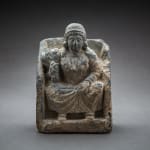Gandhara schist relief of Hariti, 200 BCE - 500 CE
Schist
height 12.7 cm
height 5 in
height 5 in
LO.510
Further images
Gandhara schist relief of Harit Small elegant figurine of Hariti, a fertility goddess and the benevolent patroness of children. Together with her husband Panchika, she is also associated with the...
Gandhara schist relief of Harit Small elegant figurine of Hariti, a fertility goddess and the benevolent patroness of children. Together with her husband Panchika, she is also associated with the embodiment of prosperity.sculpted in dark schist, portrayed seated on a large throne, wearing a long pleated skirt, her hair beautifully kept in order by a simple diadem leaving a row of snail-like curls to frame her front, one of her hands holding the vest while the other is clasping a cornucopia at the height of her shoulder. The rendition of the pleats and the posture of the person is undoubtedly drawn from the classical repertoire, once again bespeaking of the intense cultural interchange between that geographic region and the ancient Greek culture.
The Gandhara region had long been a crossroads of cultural influences. Geographically it included roughly northwestern India between the Khyber Pass and the Indus River and the region of the Kabul Valley in Afghanistan. During the reign of the Indian emperor Ashoka around 3rd century B.C., the region became the scene of intensive Buddhist missionary activity; and, in the 1st century AD, rulers of the Kushan empire such as Kanishka (AD 129-160) maintained contacts with Rome and employed foreign artists from the eastern centres of the Roman Empire to create numerous sculptural works. The many archaeological discoveries of Alexandrian and Syrian workmanship at Taxila in the Punjab and Begram in the Kabul valley testify to the cultural and diplomatic connections with the Graeco- Roman West. The choice of a soft indigenous schist -the preferred medium of the early Gandharan artists- would indicate a date between the 2nd and the 5th centuries AD. During that period local artists were able to establish a strong tradition and produced works of art reflecting both indigenous traditions and external influences. The detection of Greek and Roman elements in the Gandharan School testifies to the active exchange of ideals among all the civilizations of the Classical and Central Asian worlds. While the Gandhara artistic tradition reached its climax toward the end of the 2nd century AD with the production of the most significant large Buddha statues, the style continued to flourish well into the 3rd century, and continued thriving until and after the Sasanian invasion.
The Gandhara region had long been a crossroads of cultural influences. Geographically it included roughly northwestern India between the Khyber Pass and the Indus River and the region of the Kabul Valley in Afghanistan. During the reign of the Indian emperor Ashoka around 3rd century B.C., the region became the scene of intensive Buddhist missionary activity; and, in the 1st century AD, rulers of the Kushan empire such as Kanishka (AD 129-160) maintained contacts with Rome and employed foreign artists from the eastern centres of the Roman Empire to create numerous sculptural works. The many archaeological discoveries of Alexandrian and Syrian workmanship at Taxila in the Punjab and Begram in the Kabul valley testify to the cultural and diplomatic connections with the Graeco- Roman West. The choice of a soft indigenous schist -the preferred medium of the early Gandharan artists- would indicate a date between the 2nd and the 5th centuries AD. During that period local artists were able to establish a strong tradition and produced works of art reflecting both indigenous traditions and external influences. The detection of Greek and Roman elements in the Gandharan School testifies to the active exchange of ideals among all the civilizations of the Classical and Central Asian worlds. While the Gandhara artistic tradition reached its climax toward the end of the 2nd century AD with the production of the most significant large Buddha statues, the style continued to flourish well into the 3rd century, and continued thriving until and after the Sasanian invasion.





